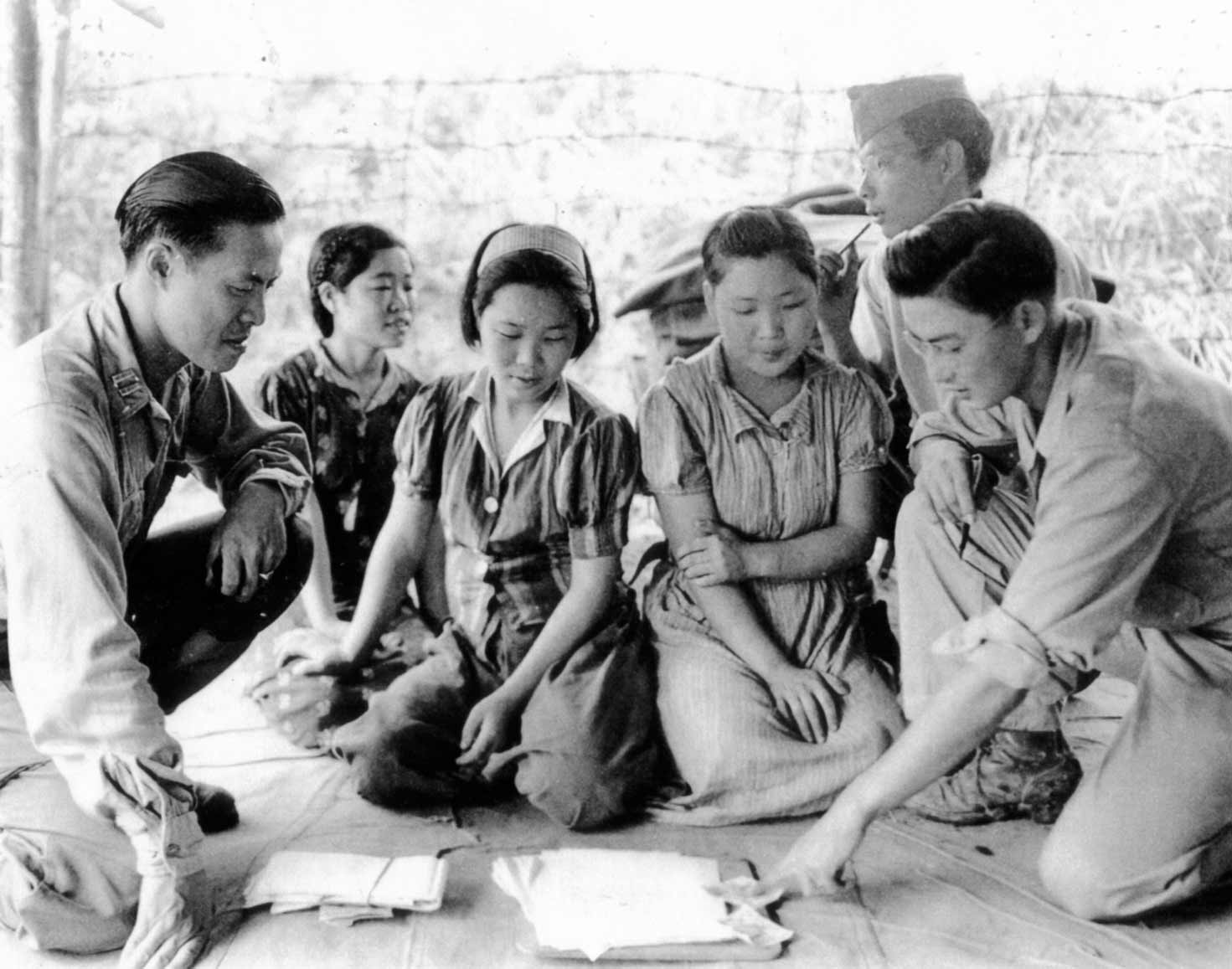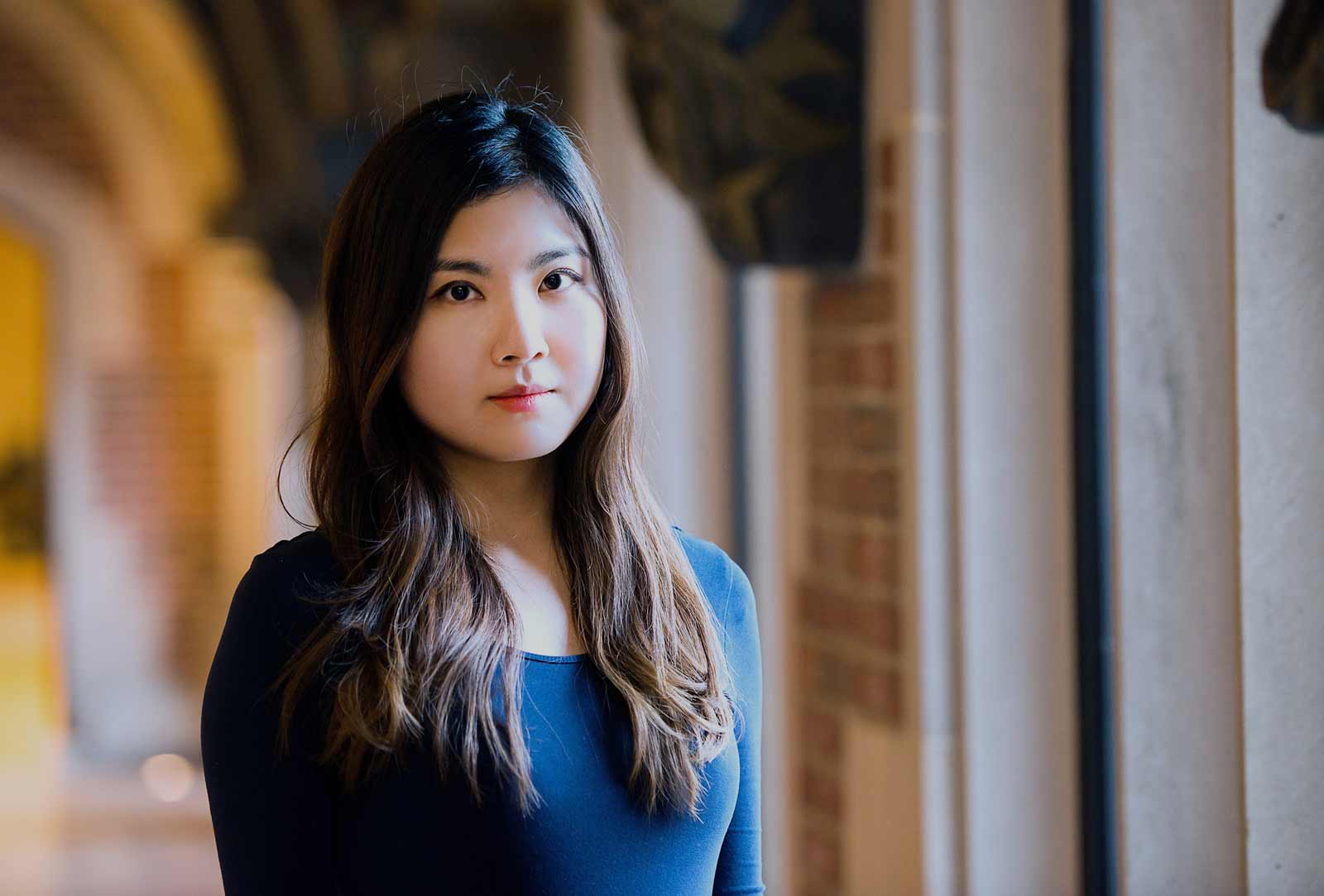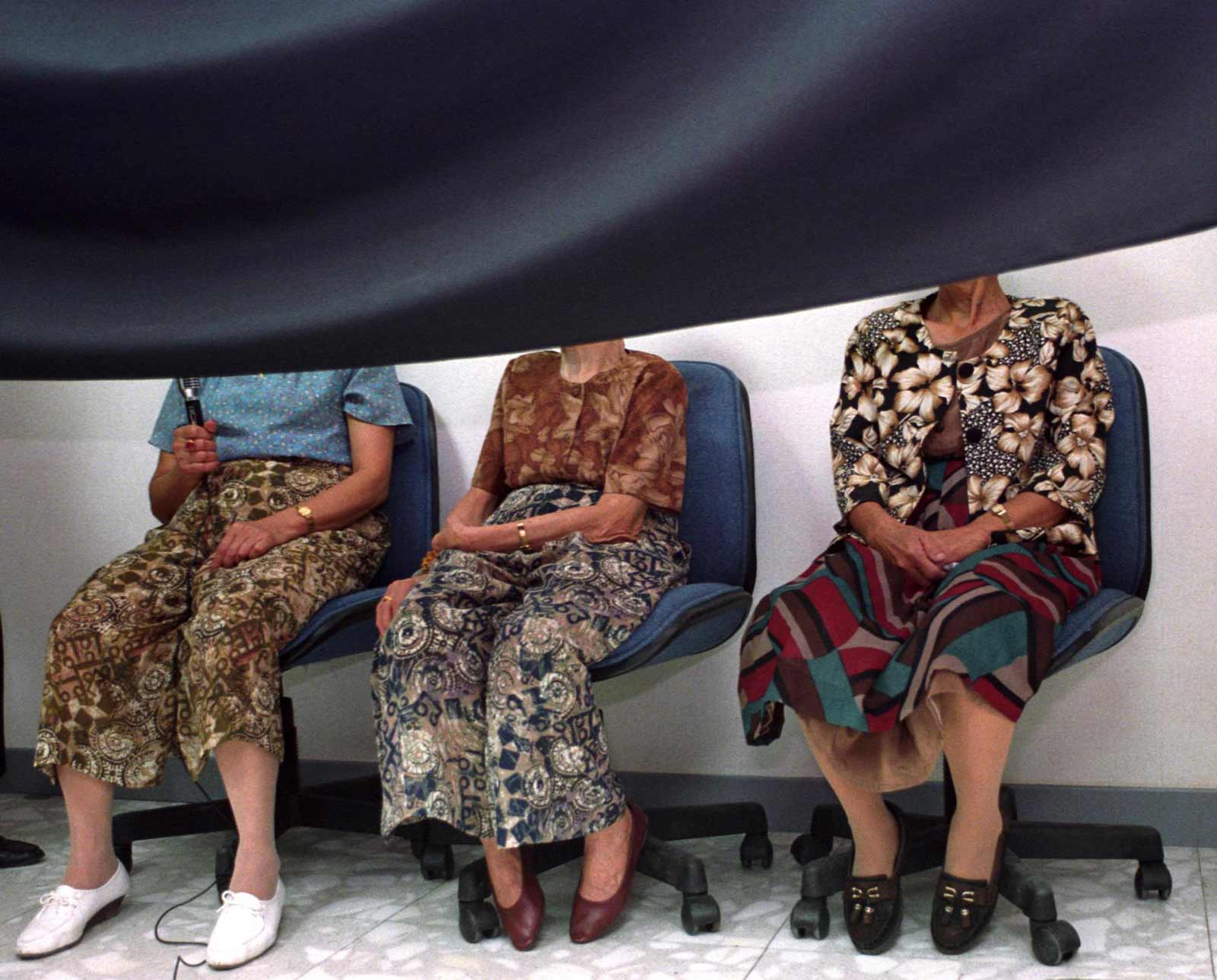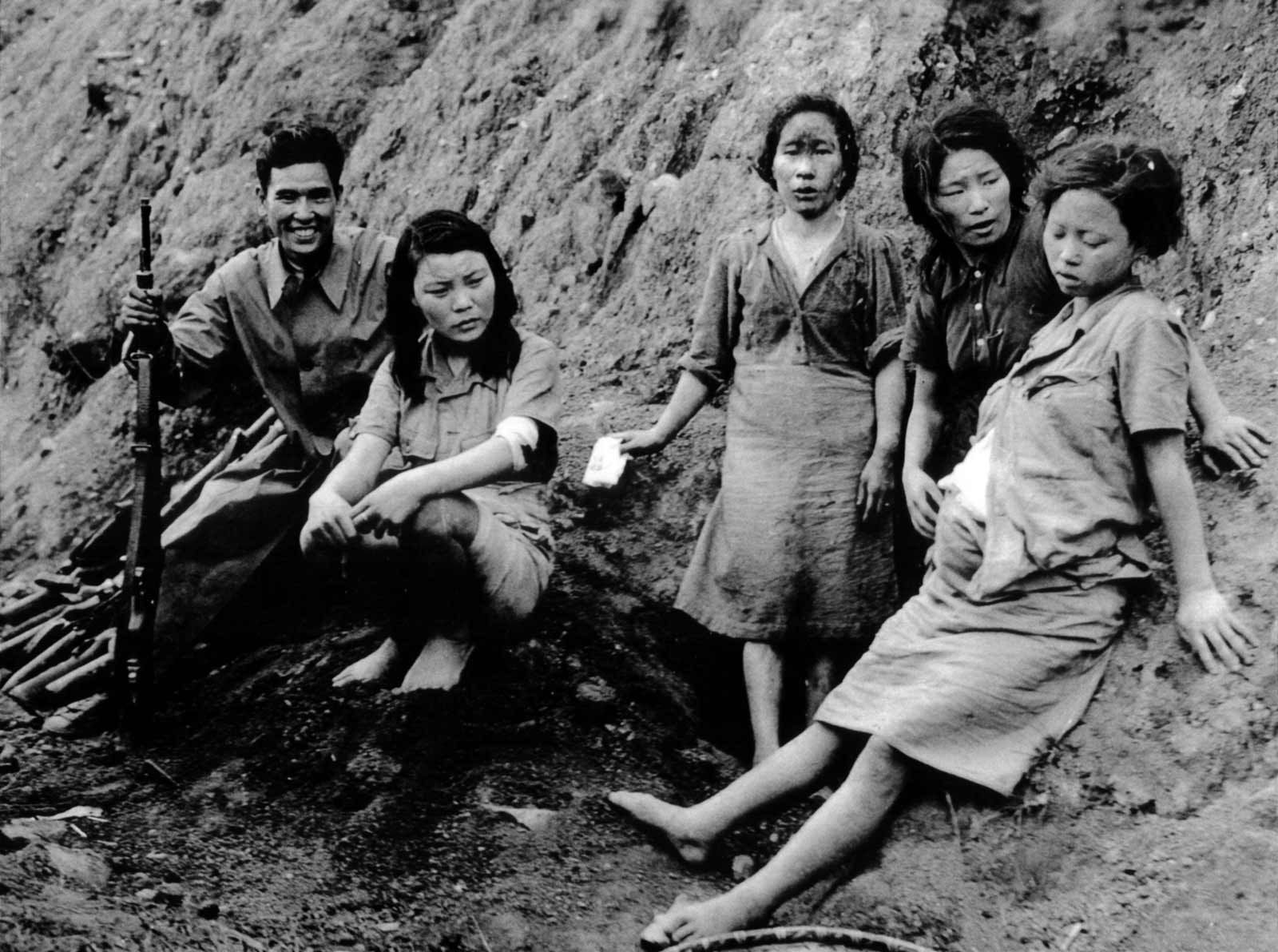Bringing Poetry to the Cruel History of Comfort Women
Maya Chung
Instead of approaching the material with the detached view of a historian or anthropologist, Emily Jungmin Yoon’s new poetry collection uses empathy to dramatize the traumas the comfort women have suffered.
October 17, 2018

US National Archives
Three Korean “comfort women” captured by US troops during a mission in Burma, with members of the US army’s Myikyina Task Force, August 14, 1944
On August 14, Korea and Taiwan unveiled two statues commemorating the 80,000 to 200,000 “comfort women,” primarily from Korea, but also from Taiwan, China, and Southeast Asia, who were forced into prostitution by the Japanese army during World War II. The two statues marked South Korea’s first “Memorial Day for Japanese Forces’ Comfort Women Victims.”
“My hope is that this issue will not lead to a diplomatic dispute between South Korea and Japan,” South Korean president Moon Jae-in said in a commemoration speech, knowing that if history has anything to say about relations between the two nations, this may well be impossible. Japan and Korea have had a vexed relationship since Japan first established colonial rule in Korea in 1910, which ended after World War II, in 1945. While Koreans were officially considered the “Emperor’s children,” they were denied many civil rights, including voting for the Diet’s Lower House, unless they were permanent residents of Japan.
Since the bronze “Statue of Peace” was constructed in front of Seoul’s Japanese Embassy by Korean activists in 2011, other monuments have gone up in Busan, Hong Kong, Taiwan, and elsewhere—met with protests by those Japanese who feel that the statues overstep a 2015 deal, whereby the Japanese government apologized to Korean victims and set up a one billion yen fund to support them. Many believe this agreement finally, irrevocably resolved the issue.
The history of comfort women is complex, not least because in the years following the war, many of the women fell into obscurity. Former comfort women struggled to reintegrate into Korean society, suffering from psychological trauma, abuse, and infertility, and no victims spoke publicly until the Nineties. Records from wartime are limited to written documentation by the men who supervised the comfort women system. There are few official records chronicling how these women were drafted into labor; those that do exist have been vague enough that Japanese officials have been able to deny evidence of forced recruitment. This contentious history has continued to reemerge over the decades since World War II: with every monument that’s raised by still-grieving Koreans, the debate is reopened.
Former comfort women experienced acute shame when they returned home after the war. Kim Hak-sun, who in 1991 became the first woman to speak publicly about her experience, revealed protracted abuse she suffered from her husband. “I had to suffer the hurt and indignity of being debased by my own husband who, when drunk, would abuse me in front of our son by calling me a ‘dirty bitch’ who prostituted herself for soldiers,” she said. Korean women were often considered traitorous and dirty for sleeping with the enemy; those who returned home struggled to recover and reintegrate as they rejoined the families they had left behind or tried to start their own.
Into this fractious space comes a new poetry collection by Korean-born poet Emily Jungmin Yoon, A Cruelty Special to Our Species, which undertakes to speak to the stories of these women. By fluidly adopting the voices of those who experienced the comfort system (she draws directly from actual testimonies in a number of her poems), Yoon shares stories that were silenced for decades. Speaking as a comfort woman returned home after the war, she writes, “My room became unfit for children. / How could I put a child in a haunted place…Every door is closed. 70 years and no one knows. No one who knows / my past is alive. Girls at the comfort stations, we were all children then.” We see the isolation this woman feels—unable to have a child, housing a decades-long secret instead. Through her poetry, Yoon delicately melds past and present to demonstrate how history, especially that of cruelty, endures.
Yoon tells a larger story of violence against women through the perspective of the comfort women. A Cruelty addresses the diplomatic tensions between Korea and Japan, but without, seemingly, a distinct political agenda—Yoon hardly expresses animosity toward Japan throughout the collection, choosing instead to highlight violence as a human cruelty that transcends nations. The holes in the historical record’s documentation of comfort women pose both a challenge and an opportunity for her, as an artist, to engage with the subject.
Central to A Cruelty is the idea that history gnaws at us, perhaps even destroys us, if we don’t sufficiently attend to it. In the first poem, which is one of several titled “An Ordinary Misfortune,” Yoon writes, “This question by a Canadian girl, a friend: Why don’t you guys just get along? The guys: Japan and Korea. Meaning: move on. How do I answer that?” In a deft twist, Yoon takes the phrase as a cue: “Move on, move on, girls on the train. Destination: comfort stations.” In a few beats, we’ve been transported three-quarters of a century back, to girls being ferried en masse to brothels.
Advertisement
As Yoon explains in her author’s note, she asks questions in her poetry to gain a deeper understanding of her “immigrant, ESL [English as a second language], Korean, and womanly experiences, and the violent history of twentieth-century Korea” that extends far beyond the immediate history of the comfort women victims. She writes, “An experience that is not mine is still part of the society and world that I occupy.”
More than a diplomatic question, the comfort women system was and remains, to Yoon, an issue of cruelty, of violence perpetrated onto women by men—the type of gendered violence which is, according to anthropologist C. Sarah Soh, at the root of the issue.

Jean Lachat
Emily Jungmin Yoon, 2017
In her book, The Comfort Women: Sexual Violence and Postcolonial Memory in Korea and Japan, Soh argues that Korea’s deeply ingrained patriarchy and lack of educational and professional opportunities for women made the comfort women system possible. The gendered structural violence of Korean society, Soh writes, “pushed these Korean women away from home and into the grossly exploitative comfort system.” Local officials and police collaborated with occupiers to recruit girls; in 1941, the Japanese Kwantung Army asked the Government-General of Korea to procure 20,000 Koreans. The Government-General dutifully recruited local town heads to convince families to send their daughters to work in Japan. Yoon doesn’t shy away from assigning blame to Koreans, either. In “American Dream,” she writes: “last night a Korean man broke into your room / and raped me, with you calm in your repose / next to me.”
*
In 1990, Director-General of Japan’s Employment Security Office, Shimizu Tadao, rejected a request by a Japanese Diet member for a government investigation of the comfort women system. Korean women responded with an open letter to the Japanese government with six demands, including that the Japanese government “admit the forced draft of Korean women as comfort women”; “that the survivors or their bereaved families be compensated”; and “that these facts be continuously related in historical education so that such misdeeds are not repeated.” Yoon has perhaps a similar goal in writing this history today. Addressing her reader in one particularly confrontational poem, “Autopsy,” she implores us not to forget, and even to assume a degree of culpability: “You holding me and whispering, Who did this to you? / sawing me into a shallow boat. / You did, you, did, you did, and you, and you, and you,” she answers.
Much of the debate over comfort women has revolved around whether they were forcibly recruited, as the above open letter asserts. In the decades since World War II, historians and researchers have identified three general methods of recruiting women. First, given the meager employment opportunities for women in their hometowns or villages, the prospect of paid work likely would have been appealing. Second, Japanese military forces would sometimes enlist local police or government to help recruit women, often by enticing them with the assurance of paid work (“Mother I decided to go / they promised a job as a military nurse in Japan,” Yoon writes in the voice of a comfort woman). Third, there was forcible kidnapping. “Madam X,” a young Chinese woman described in Australian economist George Hicks’s 1994 book The Comfort Women: Japan’s Brutal Regime of Enforced Prostitution in the Second World War, was violently raped by soldiers at her home in British Malaya, kidnapped, and taken to a bungalow in Jalan Ampang. Mun Ok Ju, eighteen, was offered a job by a local Korean man in her hometown. He said she’d be able to make money to send back home to her impoverished family. Told she would find work in a restaurant, she was diverted to a comfort station. During her time there, she was forced to hand over half her earnings to the man who had collected her from Korea.
Long before World War II, prostitution in Japan was already widespread, organized, and legal. From the pleasure quarters of cities like Kyoto and Tokyo to the much-glamorized practice of geisha entertainment, prostitution was a smooth-running, state-sanctioned operation. When Japan annexed Korea in 1910, it introduced a system of military police-controlled prostitution. This organized system called for official registration for all parties involved, as well as regular medical checks. Even before full annexation, a red light district was established, under Japanese influence, in Seoul to better regulate prostitution. As Hicks argues, it’s no surprise that the Japanese army was able to expand the system during wartime. According to Japanese traditional beliefs, Hicks writes, having sex before battle meant soldiers would be protected from injury, while lack of sex made men prone to error and accident. The comfort women system was justified as a necessary feature of Imperial Japan’s military strategy.
Advertisement
The first comfort stations operated by the Japanese army appeared in 1932 in Shanghai. After 223 reported rapes by Japanese soldiers, the governor of Nagasaki Prefecture sought an administrative solution to the problem and sent a group of Korean comfort women from the North Kyushu Korean community in Japan to Japanese-occupied Shanghai. Regulations included hours of operation, fees, and the mandatory use of a condom. This arrangement laid the groundwork for the systemic forced prostitution that would occur during the war.
Life at wartime comfort stations involved near-imprisonment—women weren’t allowed to leave the brothel without a pass—meager rations and supplies, and weekly venereal disease inspections, as well as frequent sexual violence from soldiers. Though women were nominally paid for their services, payment was scant and inconsistent. In general, Japanese women were paid more than Koreans. According to Madam X, the “mama-san” took half the money the comfort women earned at their stations before paying them. Sometimes, they weren’t paid at all.
*
Japan believes that its 2015 agreement, including monetary reparations to survivors and an apology from Japan’s prime minister, was enough to make amends for wartime transgressions. Both South Korea and Japan agreed to consider the deal a final resolution of the matter. Although the UN’s Committee on the Elimination of Racial Discrimination asserted this year that Japan’s efforts had not adequately consulted survivors, and that the 2015 deal “did not provide unequivocal responsibility for the human rights violations committed against these women,” Japanese officials have said that the 2015 deal had “finally and irreversibly” settled the issue.

Tao-Chuan Yeh/AFP/Getty Images
Three former comfort women at a press conference, Taipei, August 13, 1992
Many Koreans disagree: in early September, former comfort women and members of an activist group announced they were planning month-long rallies outside Korean government buildings to publicize their rejection of the reparations and demand a further apology from Japanese Prime Minister Shinzo Abe, including a wholehearted acceptance of wrongdoings perpetrated by the Japanese Army and government against Koreans. Many Japanese, particularly on the nationalist right, refuse to recognize efforts to commemorate comfort women. Government leaders have responded with indignation, defensiveness, and even violence when faced with peaceful protest. (Surveillance footage from September of this year appears to show Mitsuhiko Fujii, a member of a visiting Japanese delegation to Taiwan, deliberately kicking a comfort women statue just outside the Kuomintang party office in Tainan.)
Over the past few years, Abe has attempted, at many turns, to delegitimize the Kono Statement, the 1993 report issued by former Chief Cabinet Secretary Yohei Kono that found, after an official investigation, that the Japanese Imperial Army had indeed forced comfort women to work in army-run brothels during the war. Abe’s government denied in 2007 that there was any documentary evidence of forced recruitment, and declared the Kono statement was not commensurate with official policy.
This comes down to a debate over the reliability of witness testimony, and the problems caused by lack of documentation. In 1983, Yoshida Seiji, a former Japanese soldier, wrote a memoir detailing his wartime experience in which he admitted his participation in the kidnapping and forced labor of comfort women. A year before the Kono statement, historian Hata Ikuhiko discredited Yoshida’s writings, particularly his report of “hunting” women on Jeju Island. Hata spoke to men who had worked at the factory where Yoshida claimed to have hunted, and found that no women had been drafted as prostitutes.
In 2014, the Asahi Shimbun, a respected Japanese newspaper, acknowledged that stories it had reported two decades prior, based on Yoshida’s testimonies, were erroneous. Abe grasped this opportunity to call the forced sex claims “baseless” and “slanderous.” Then, in 2007, Abe signed an advertisement in a New Jersey newspaper that opposed the construction of a monument to comfort women in Palisades Park, New Jersey, a town with a significant Korean population, on the basis that comfort women were simply licensed prostitutes. In Japan, it has become almost treasonous to describe the history of comfort women as sexual slavery.
*
According to a 2017 poll, 70 percent of Koreans believe the history of comfort women has remained unresolved, while 50 percent of Japanese respondents feel the issue remains unsettled despite the 2015 agreement. Moon’s administration has promised renewed efforts to commemorate these women, announcing plans for a dedicated museum and research center.
Fewer than thirty-five former comfort women remain alive today. While Abe seems keen to rewrite the past to paint Japan’s part in the war more favorably, Koreans also run the risk of making the surviving comfort women into props for a nationalistic cause. Some have argued that the peaceful bronze statues of clearly young girls paint Koreans as pure, innocent victims with no agency, which wasn’t necessarily the case. Widespread modernization under Japanese occupation may have had the effect, Soh argues, of exposing rural Korean women to new possibilities for freedom and independence.
Education expanded and modernized under Japanese rule, and girls and women were further integrated into an education system that had previously excluded them (Confucian mores discouraged women from leaving their houses to pursue learning). The Women’s Voluntary Service Corps was a major source of prostitution recruitment, cloaked as an educational opportunity. In 1938, Pae Chok-kan expressed excitement at leaving her village in Korea, wearing Western clothing, to work in a cotton factory, saying, “I felt like I’d shed my deep-mountain village boorishness.” She never made it to the factory, and was instead taken to a comfort station in China. Adopting the voice of a former comfort woman, Yoon writes, “I hoped one of the orders was for me to work at a factory.” Instead, she goes on to describe a sickly sight at the army barracks: “girls… injected / with so many drugs”; “nameless animals / exploded on top of us.” The Corps was designed for labor in war industries, but members frequently ended up serving as prostitutes instead. It was a particularly effective recruiter of poorer women with limited access to education.

US National Archives
Comfort women and prisoners of war with a Chinese soldier, September 3, 1944
While Abe refuses to acknowledge these women as sex slaves to protect national pride, Soh opposes the label for a different reason: she believes the characterization is reductive, and takes away from the women’s agency in confronting oppression and modernizing their lives. Still, it’s undeniable that Japan’s power facilitated the extent to which Korean women were drafted into service, and being a comfort woman was less a clear choice when the majority of the women who were enlisted were poor. Though we may not characterize each and every relation between a soldier and the prostitutes who serviced him as an act of sexual violence, the system effectively took women from one oppressed existence and placed them in another.
*
Instead of approaching the material with the detached view of a historian or anthropologist, Yoon’s A Cruelty uses empathy and poetry to dramatize the traumas the comfort women have suffered. In “Fear,” she writes, “I wanted to carve it out of me— / become a fjord flanked by historic cliffs. How else / could I write the years / I did not live.”
While the few novels that have been written about comfort women fail in many ways, according to Soh—through historical inaccuracy, or bad prose—Yoon makes no promise of providing a historically accurate work of art, though the testimonies she quotes directly do lend her credibility. Poetry allows Yoon to move fluidly between time periods, taking on different perspectives, traveling from World War II to the present day, from the perspective of a former comfort woman to that of a modern Western woman. She transcends the politics, refusing to engage in the diplomatic dispute, and powerfully addresses the human suffering that one group inflicted on another—that men, both Korean and Japanese, inflicted on women.
By writing in English, Yoon implicates those of us who may feel removed from this history, and informs a Western audience whose World War II education has likely focused nearly entirely on Europe. Yoon demonstrates how these stories cling to us as the years progress, though neither she nor her readers lived the experience of these women. She even goes so far as to point a finger directly at Americans, who have their own history of Korean occupation; in one poem, Yoon writes from the perspective of her grandmother: “We didn’t fear war. We feared the allies.”
Yoon makes it clear that her investment is with the women; her poetry is decidedly not anti-Japan, but ardently anti-violence. In the voice of a former comfort woman who struggles to reintegrate, she writes, “You’d think a former comfort woman would hate the Japanese. I don’t. I / hate men and I hate sex. I hate the sight of my son-in-law, who lives in this / house.” Yoon’s poetry is about the cruelty human beings enact on each other, whatever their ethnicity. It’s a recognition that history never leaves us. Both Korea and Japan might do well to abandon their routine of provocation and retaliation, and instead focus their attention on the women who were damaged for life.
Subscribe to our Newsletters
Best of The New York Review, plus books, events, and other items of interest
Submit a letter:
Email us letters@nybooks.com
More by Maya Chung
The Writer’s Mind
August 7, 2021
The Marvel of Comics, If Not of Movies
July 31, 2021
See Rome and Feel Alive
May 1, 2021
Maya Chung
Maya Chung is on the editorial staff at The New York Review.
No comments:
Post a Comment